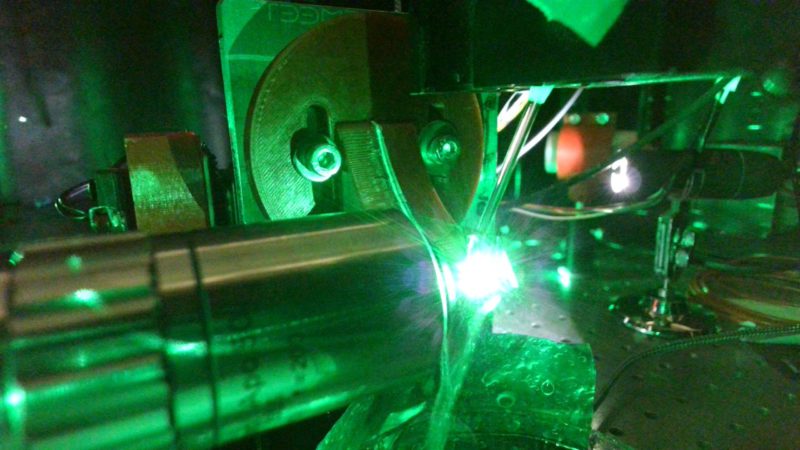Provo company Nielson Scientific has continued to grow without taking on debt and with no outside investors. Under CEO Greg Nielson, the company has stayed lean and relied on intentional strategies that have proven immensely important to the company’s growth. The company leverages non-dilutive R&D funding through a competitive federal program, finds niche ways to commercialize products, utilizes Utah Technology Innovation Funding (UTIF), and creates strategic partnerships.
These strategies, along with a recent grant from the U.S. Department of Energy (DOE) for $1,150,000 through the competitive federal Small Business Innovation Research (SBIR) program, will allow the company to continue its development of a large-area, nano-laser-ablation tool for filters.
The Phase II SBIR grant allows Nielson Scientific to further develop their ablation tool, supporting the capability of filter design and the testing to provide custom fabricated multi-layer metal mesh filters for various THz applications. One application is for advanced telescopes used by the Cosmic Microwave Background Stage IV (CMB-S4) experiment. This project will explore the light emitted not long after the Big Bang. Nielson Scientific’s tool will assist in filtering out unwanted light, allowing the relevant light to be detected and then studied. The THz filters the company is developing can also be used in security and medical screening, taking the place of x-rays in some cases without the harmful side effects, as well as advanced wireless communication protocols (i.e., “6G”).
Nielson Scientific’s finely controlled ablation tool can quickly cover large areas and is one of a kind with many applications beyond THz filter manufacturing. These applications include semiconductor microfabrication and advanced packaging, printed circuit board manufacturing, superconducting flex cables, various medical devices, and other micro-structured devices. According to founder and CEO Greg Nielson, Nielson Scientific is already pursuing many applications for the company’s ablation tool to add to its portfolio. One application is a sensor component used at the National Ignition Facility, the largest and most powerful inertial confinement fusion (ICF) research device at the Lawrence Livermore National Laboratory.
Nielson is excited about how quickly products have reached customers since he only started a little over five years ago after working for Vivint Solar and Sandia National Labs. Before that, he received a bachelor’s degree from Utah State University and a master’s and Ph.D. from MIT. His company has steadily grown since its inception using the four strategies laid out above. And while the company has grown, it has stayed true to its core expertise which uses light and special lasers for advanced manufacturing, including 3D microfabrication of semiconductor materials.
While at Vivint Solar, Nielson heard about the SBIR/STTR program and the Utah Innovation Center (UIC) for the first time. On his own, he attended a UIC SBIR 101 workshop and was impressed with the dedication and knowledge of the team. Nielson started writing proposals for SBIR grants as his product’s vision and company began to take shape. He found the UIC’s expertise and assistance invaluable because of the many nuances of the SBIR/STTR programs, specifically the financial and budgeting information needed for proposal submission. The Innovation Center knew all the tips and tricks he required for a successful first submission. And while Nielson Scientific doesn’t need as much assistance these days, in the beginning, the Innovation Center helped proofread proposal drafts and abstracts and provided letters of support, which Nielson said was incredibly helpful.
“The Utah Innovation Center has seen so many proposals,” said Nielson. “It was beneficial to have them look at our work.”
In addition to the proposal and technical assistance, the Utah Innovation Center distributes funding to SBIR/STTR applicants through the Utah Technical Innovation Funding (UTIF) program. Nielson Scientific received two UTIF nonrecourse loans. The loans allowed the company to purchase a costly, specialized laser which was a vital component of the system they were building, allowing them to pursue an SBIR Phase II award following a successful Phase I project.
Lastly, Nielson Scientific’s partnerships with local and national universities have proven invaluable to the business’ growth and development. Partnering with Brigham Young University, the University of Utah, and others have allowed access to labs, expensive tools like microscopes and fabrication tools, and brilliant students. In turn, the students get exposure to groundbreaking research, which helps the universities fulfill the mission of providing education and opportunities to students. It has proven a win/win for the company and the universities.
When asked what advice Nielson would give those beginning their SBIR journey, he replied, “Something that has proved incredibly important to us is focusing on our customer’s needs early in the product development process. Whatever our basic capability, we ask, ‘We can do this. Is this of value?’ And we have gotten some projects and revenue from that. And it has helped us focus on what is most important to our customers. So, focusing early on customers and what they need and trying to deliver something to them as soon as possible is extremely useful in developing your product.”
Nielson Scientific continues to gain momentum and strategically grow with three current SBIR proposals under review and their customers’ needs always in mind.
